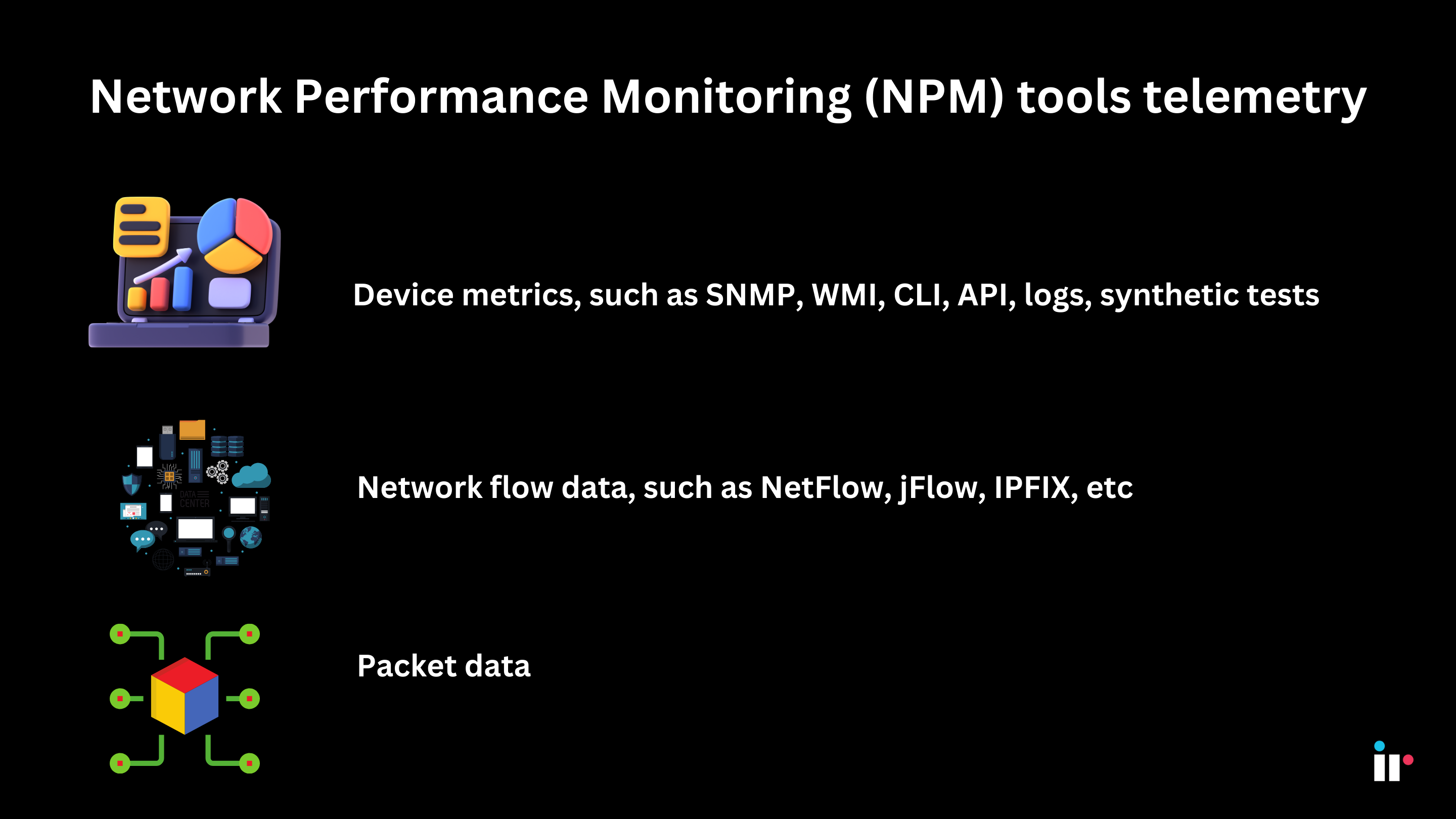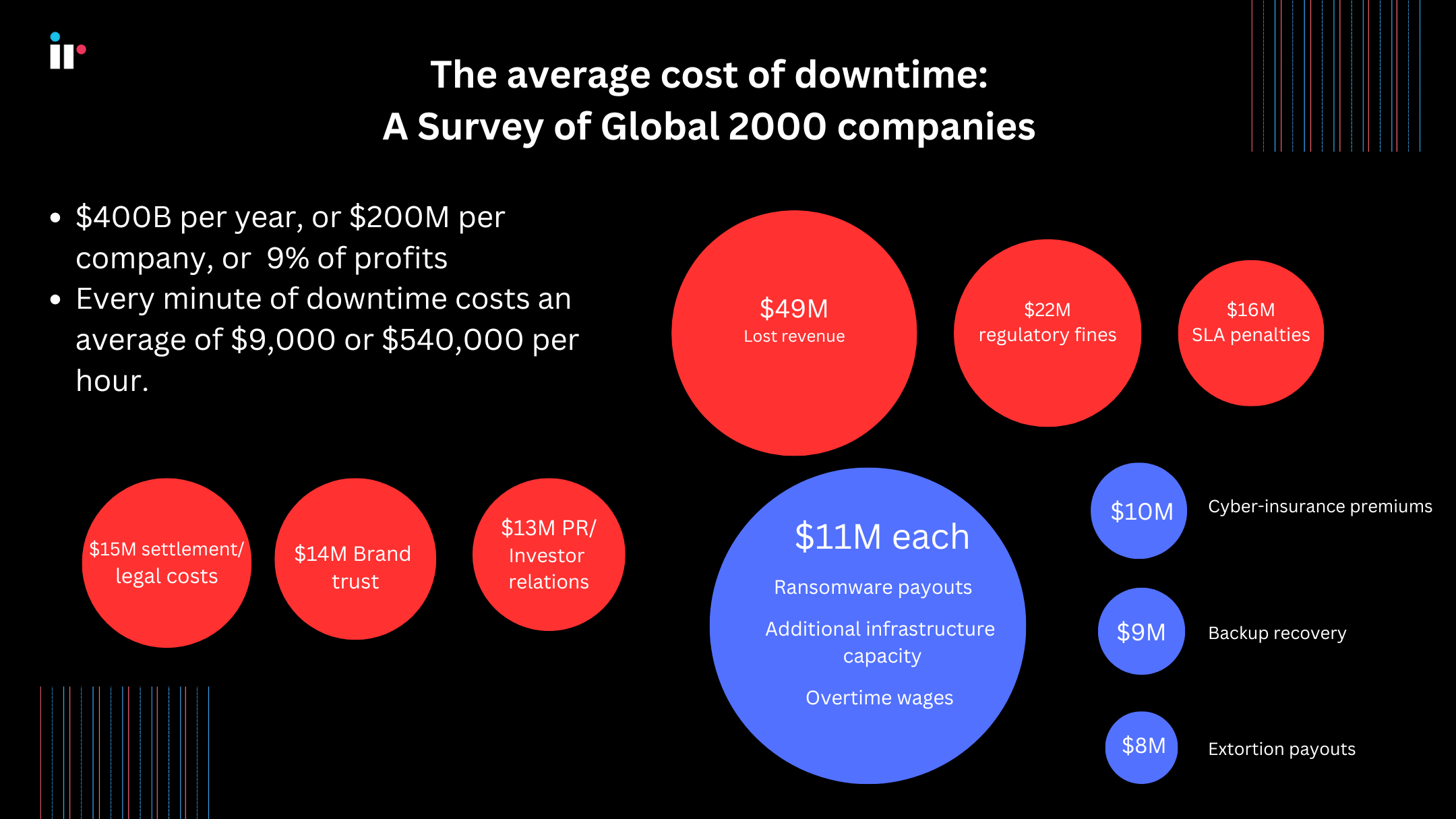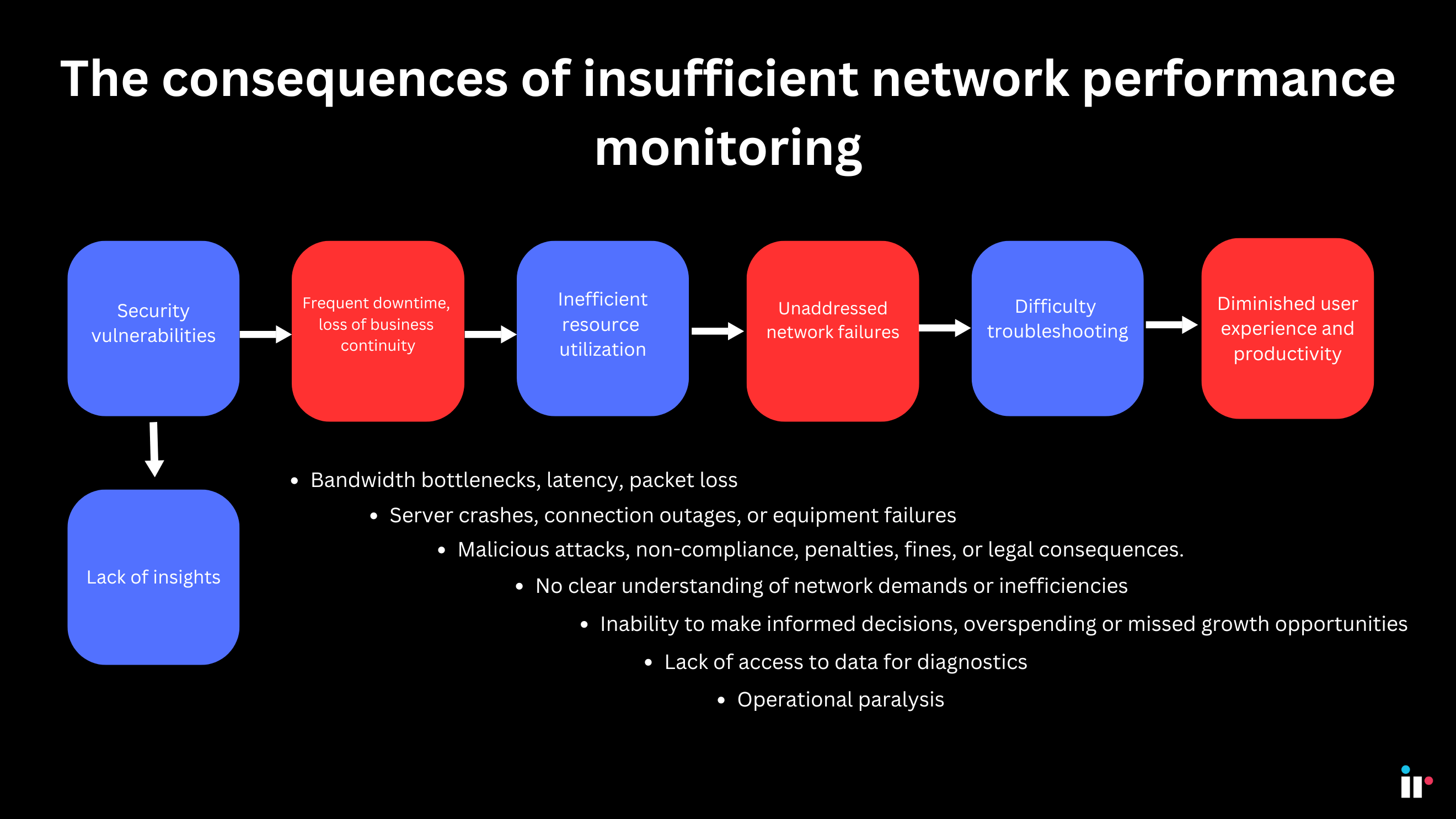In today's highly connected and digital environment, network performance monitoring is absolutely crucial for businesses to maintain a healthy network ecosystem.
Given the size and complexity of today's enterprise organizations, and the critical role that networks play in business operations, network performance monitoring tools provide the best assurance of optimal network health.
The global network performance monitoring market is worth around US$1,625.5 million in 2024, and estimated to reach a value of US$5,632.1 million by 2034. This represents a CAGR of 13.2% over the next decade.
The importance of network monitoring will only increase, and with the rise of IOT devices, it's estimated that by 2025, 75.44 billion connected devices will be generating an almost unfathomable amount of network data.
What is network performance monitoring?
Network performance monitoring is an all-encompassing term, but it involves visualizing, tracking, optimizing, troubleshooting and reporting on the health and availability of your network as experienced by your users.
Network Performance Monitoring (NPM) tools can utilize different types of telemetry, including:
-
Device metrics, such as SNMP, WMI, CLI, API, logs, synthetic tests.
-
Network flow data, such as NetFlow, jFlow, IPFIX, etc.
-
Packet data.

What is network telemetry?
Network telemetry simply means the collection, measurement, and analysis of data from a network's devices and infrastructure to gain insights into network performance and behavior.
There are several types of network telemetry methods used to monitor and manage networks effectively:
-
SNMP (Simple Network Management Protocol): SNMP is a powerful tool that enables the sharing of information among various devices on a network, regardless of their hardware or software. It's a widely used and important protocol for network traffic management and monitoring, allowing network administrators to collect and organize information about network devices, including routers, switches, and servers.
-
Performance Monitoring Telemetry: This type of network monitoring telemetry focuses on measuring and analyzing various performance metrics of network devices and links. It includes monitoring parameters such as bandwidth utilization, latency, packet loss, jitter, and error rates. Performance monitoring telemetry helps identify bottlenecks, optimizing network resources, and ensuring efficient network operation.
-
Endpoint Telemetry: Endpoint telemetry is a crucial factor in reducing the time taken to identify and remediate security incidents. It helps to minimize visibility blind spots, detect adversary behaviors such as fileless malware and other malicious activity. It also provides a more accurate context by gathering supplementary data from endpoints. This allows security teams to more reliably determine whether activity is malicious or benign, conduct forensic investigations to understand the full scope of malicious attacks - and respond more quickly and effectively.
The consequences of insufficient network performance monitoring
Without the right network performance monitoring solutions in place, the risks to organizations can be severe and wide-reaching, affecting its operations, security, customer satisfaction, and financial health.
Inadequate network monitoring can have the following serious consequences that no enterprise organization wants to deal with.
Frequent downtime, leading to loss of business continuity
Enterprise networks often support mission-critical systems such as eCommerce platforms, financial systems, customer support centers, and employee communication tools. Without network monitoring tools in place to watch over these systems, networks are vulnerable to disruptions that can result in operational paralysis.
The cost of downtime due to network outages can mean thousands or even millions of dollars per hour in lost revenue, reduced productivity, and reputational damage that is often impossible to repair. Network performance monitoring tools help to identify and resolve issues before they lead to major downtime.
In a survey of 2,000 large enterprise executives conducted by Cisco owned data analytics company, Splunk, The Hidden Cost of Downtime reveals the massive impact and cost of downtime:

Lost revenue is number one on the list of direct costs at $49M annually, followed by regulatory fines, SLA penalties and legal costs. Loss of revenue according to CFOs surveyed, takes 75 days to recover.
Unaddressed network failures
Without proper network performance monitoring, network issues like server crashes, connection outages, or equipment failures may go unnoticed until they cause a complete breakdown.
This leads to extended recovery time, affecting business operations. Mission-critical applications like email, ERP systems, and customer-facing services may go offline, halting business processes, affecting revenue, and leading to reputational damage.
Diminished user experience and productivity
If employees experience slow, unresponsive applications, slow file transfers, or frequent network outages, productivity suffers. Without network monitoring, issues like bandwidth bottlenecks, latency, or packet loss can lead to slow application performance.
A network performance monitoring solution ensures that critical applications (email, ERP systems, collaboration tools) run smoothly.
Without monitoring, network and application performance is subject to connectivity issues that cause disruptions in employee workflows, particularly for teams relying on collaboration tools, VoIP systems, or cloud-based applications.
For enterprises that provide digital services or eCommerce interactions, slow or unresponsive systems can result in poor customer experiences, leading to customer churn. Network monitoring ensures that service levels remain high, leading to better customer satisfaction.
Security vulnerabilities
Insufficient network monitoring makes it difficult if not impossible to detect unusual traffic patterns or unauthorized access attempts, leaving the network vulnerable to security threats like Distributed Denial of Service (DDoS) attacks, ransomware, or data breaches.
Without visibility into network activity, every network device is open to malicious attacks, which can operate undetected for long periods, exfiltrating sensitive data and causing long-term damage.
Additionally, many industries have strict compliance standards (e.g., HIPAA, GDPR) that require a continuous network performance monitoring system. Inadequate monitoring can lead to non-compliance, resulting in penalties, fines, or legal consequences.
Inefficient resource utilization
Without network performance monitoring, businesses may not be aware of how their bandwidth is being utilized, leading to inefficient allocation. Bandwidth monitoring is important, as non-essential traffic can consume valuable bandwidth, and considerably slow down critical applications.
Additionally, without a performance monitor, lack of network visibility can lead to over-investing in network infrastructure or cloud services that are not fully utilized, wasting financial resources. Conversely, under-provisioning of bandwidth and network resources can result in network congestion and performance degradation.
Without network performance monitoring software, organizations without may struggle to manage IT costs effectively, as they have no clear understanding of network demands or inefficiencies.
Difficulty in troubleshooting
Without the right network performance monitoring tools, IT teams would have to perform manual network monitoring to identify the source of issues. It goes without saying that this would be a time-consuming and error-prone, reactive process, leading to longer resolution times.
Another consequence of insufficient network monitoring is lack of access to data for diagnostics. Network performance monitoring provides detailed data logs and historical performance records, which are necessary for troubleshooting recurring issues. Without these, IT teams have no benchmarks or performance history to analyze.
Lack of insights for decision-making and business growth
Effective network performance monitoring generates valuable data for business decision-making, such as identifying trends, predicting future needs, and optimizing infrastructure investments.
Without this data, business leaders and IT managers have no way of making informed decisions, and this could lead to overspending or missed growth opportunities.
Digital transformation elements such as cloud migration, hybrid environments, IoT integration, and AI initiatives increasingly rely on robust network performance. Monitoring network performance is essential to help organizations adopt new technologies and optimize their IT strategy effectively.

Core Features to Look for in a Network Performance Monitor
We've already established that network monitoring solutions are crucial for IT professionals to ensure their networks’ health, performance, and security. But with so many options available in the market, you should know what features to prioritize when selecting an NMS solution.
Most network performance monitoring software can carry out necessary monitoring processes, but you need to think of the requirements across your entire network.
Consider whether the software is capable of full remote monitoring, and whether the solution encompasses cloud networks including multi-cloud environments.
There are a multitude of capabilities available in advanced network monitoring software today. Ideally your organization should be typically focused on longer term network performance monitoring software.
Here are the most important features to look for in network performance monitoring tools.

1. Network road-mapping
An efficient network performance monitoring tool needs the ability to automatically identify and map all devices and connections within a network.
This feature saves valuable time and resources, and ensures that every component of your network is accounted for, including those that might have been overlooked or forgotten. Ideally your network performance monitor should have these features:
Automated inventory
Automatically keeps track of multiple devices, saving considerable time and reducing the risk of human error.
Dynamic network mapping
Enables a visual representation of the network across the entire network, simplifying troubleshooting and offering a better understanding of the network structure.
Early detection of unauthorized devices
Helps identify potential security threats by detecting new and possibly unauthorized devices on the network.
2. Real time network monitoring
An effective network performance monitor is like an all-seeing-eye, ensuring that your network runs smoothly and meets the evolving demands of your organization. The ability to monitor network performance, including network traffic in real-time is pivotal for every enterprise organization.
IT professionals can see what’s happening on their network at any given moment, allowing for immediate response to issues as they arise. Your network performance monitor should ideally allow:
Instant problem identification
The ability to quickly pinpoint the source of traffic bottlenecks, network performance issues or failing devices, etc.
Bandwidth monitoring
Helps in understanding bandwidth and resource usage patterns, predicting and eliminating bottlenecks, as well as identifying potential overloads.
Proactive maintenance
Rather than reactive processes that lengthen response time, proactive network monitoring in real time enables IT teams to reduce downtime by addressing problems before they escalate.
Traffic analysis and QoS
Ensures that critical applications are allocated the bandwidth they need, improving overall network efficiency.
Capacity planning
This feature helps predict future network requirements and is helpful in guiding infrastructure investments.
3. Advanced network reporting and customizable dashboards
An advanced network monitoring tool collects performance data and offers comprehensive reporting capabilities and intuitive dashboards. This allows for the easy interpretation of complex data and helps administrators make informed decisions.
Customizable reports
Your network performance monitor should provide tailored reports to meet your organization’s specific needs.
Historical data analysis
Enables IT administrators to identify trends, and long term data, which helps forecast future network needs.
User-friendly dashboards
Provides a centralized view of network health, simplifying management and monitoring tasks.
4. Advanced alerts and notifications
What we consider the 4th most important feature to look for in network performance monitoring tools is a robust system for alerts and notifications.
This feature ensures that network administrators are immediately alerted to any network problems or issues, allowing swift action to prevent or minimize disruptions. Your network monitoring solution should provide:
Immediate Incident Awareness
Your network monitoring software should provide alert and notifications in real time for a fast response to network issues or failures.
Customizable Alerts
You should be able to tailor alert conditions and thresholds to suit your network’s unique requirements.
Escalation Protocols
Network monitoring software should ensure that critical alerts reach the right people quickly, to streamline and expedite the resolution process.
Read our ultimate guide to network monitoring
Network Monitoring 101: Tools, Metrics, and Best Practices
The difference between active and passive network monitoring systems
Generally speaking, network monitoring software falls into two categories:
-
Active Network Monitoring
-
Passive Network Monitoring
Although both work towards the same goal, they use varying methodologies in their functioning
Active Network Monitoring is often referred to as Synthetic Monitoring. This method injects test traffic into the network to find faults or issues within the network, helping find and report real-time data such as packet loss, jitter, HTTP response time, and so on.
Passive Network Monitoring involves recording and analyzing the actual user traffic to understand network usage trends, tracking which network elements are consuming available bandwidth. It works with actual user data instead of injecting test data to analyze the traffic. Most network monitoring solutions use both methods.
Regular updates and security
It's important to ensure that your NPM tools are configured properly. Some systems, like the Solarwinds network performance monitor requires stringent security measures. Proper configuration and regular updates are crucial to protect against vulnerabilities that could potentially compromise network data.
Why choose IR Collaborate as your preferred network performance monitor
In this guide we've established that network performance monitoring software is mission critical for every enterprise organization.
IR Collaborate performance management solutions are utilized by hundreds of the world's largest organizations to optimize their business-critical systems.
Our world-class network monitoring solutions provide deep insights, comprehensive monitoring and 24/7 support to keep payment hubs, unified communications ecosystems and contact centers running as they should.
One dashboard for end-to-end visibility
Broad multi-vendor coverage means you can streamline IT processes and operations with visibility across your entire environment from a single pane-of-glass.
Boost user experience
Improve the performance of video conferencing and collaboration tools to optimize productivity and keep your modern workforce connected.
On-premise or cloud ready
Deploy our versatile solutions in the cloud, on premises or as a hybrid model, to suit your enterprise unified communications needs.
Fast, proactive monitoring and troubleshooting
Find and fix root-cause of problems quickly so you can maximize system performance and minimize user impact.




